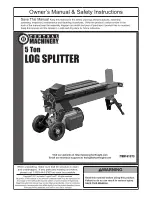
2
18
Check the machine for possible damage
−
Before continuing to use the machine, the protective
devices must be inspected to ensure that they work
perfectly and with their intended function
−
Check whether the movable parts function perfectly and
do not stick or whether the parts are damaged. All parts
must be correctly installed and fulfil all conditions to
ensure perfect operation of the machine.
−
Damaged guards and parts must be properly repaired or
exchanged by a recognized, specialist workshop; insofar
as nothing else is stated in the instructions for use.
−
Damaged or illegible safety warning labels should be
replaced immediately.
Electrical safety
Electrical connections must conform to IEC 60245 (H 07 RN-
F) with a cable cross-section of at least
⇒
230 V ~
3 x 1.5 mm² for a maximum cable length of up to 10 m
Never use the machine with a power supply cable of over 10
m in length. Longer power supply cables will cause a drop in
voltage. The motor will not be able to provide its maximum
performance and the operation of the machine will be
impaired.
Plugs and coupler outlets on connection cables must be made
of rubber, plasticised PVC or other thermoplastic material of
same mechanical stability or be covered with this material.
The connector of the connection cable must be splash-proof.
When running the connection line observe that it does not
interfere, is not squeezed, bended and the plug connection
does not get wet.
Wind off completely the cable when using a cable drum.
Do not use the cable for purposes for which it is not meant.
Protect the cable against heat, oil and sharp edges. Do not
use the cable to pull the plug from the socket.
Regularly check the extension cables and replace them if they
are damaged.
Do not use any defective connection cables.
When working outdoors, only use extension cables especially
approved and appropriately labelled for outdoor use.
Do not set up any provisional electrical connections.
Never bypass protective devices or deactivate them.
The electrical connection or repairs to electrical parts of the
machine must be carried out by a certified electrician or one
of our customer service points. Local regulations –
especially regarding protective measures – must be
observed.
Repairs to other parts of the machine must be carried out by
the manufacturer or one of his customer service points.
Use only original spare parts. Accidents can arise for the
user through the use of other spare parts. The manufacturer
is not liable for any damage
or injury resulting
from such
action.
T
T
r
r
a
a
n
n
s
s
p
p
o
o
r
r
t
t
I
I
n
n
s
s
t
t
r
r
u
u
c
c
t
t
i
i
o
o
n
n
s
s
Move the splitting blade right down every time before the
machine is transported.
To transport the machine,
grasp the handle and tilt
the log splitter slightly
towards you. The log
splitter can be easily
transported in this
position.
Make sure that the oil
tank cap is securely
tightened to prevent oil
from leaking during
transport.
P
P
o
o
s
s
i
i
t
t
i
i
o
o
n
n
i
i
n
n
g
g
Ensure that the working area meets the following conditions:
−
no danger of slipping
−
level
−
free of obstacles
−
sufficiently well lit
Do not operate the machine in the direct vicinity of gas
or petrol pipes or containers, or any other easily inflammable
materials.
S
S
t
t
a
a
r
r
t
t
-
-
u
u
p
p
Check that the machine is completely and correctly
assembled.
Before using the log splitter, make sure each time that
−
there are no faulty connections (tears, cuts, etc.)
Do not use defective power supply cables.
−
there are no damages at the machine
−
all screws are tight
−
check the hydraulic system for any possible leaks
−
the oil level
Venting
Vent the hydraulic system before putting the log splitter into
operation.
¾
Unscrew the oil cap by several turns so that air may
escape from the oil tank.
¾
Leave the oil cap open during operation.
¾
Close the oil cap before moving the log splitter, as
otherwise oil will leak at this point.
oil cap
































